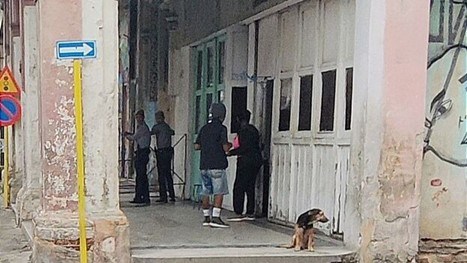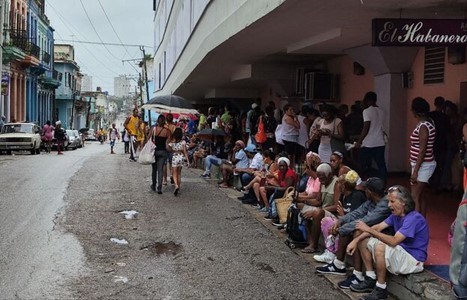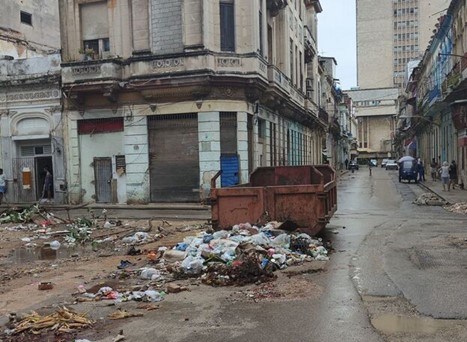Idalia Left Power Cuts & Collapsed Buildings in Western Cuba

The Police keep under surveillance the building located at Prado 352, whose inhabitants have protested on several occasions…
By Juan Diego Rodríguez (14ymedio)
HAVANA TIMES – The two-story building located at number 352 Paseo Del Prado at Virtudes in Havana suffered a partial collapse on Tuesday after the rains caused by Hurricane Idalia. According to 14ymedio, the police have the property under surveillance. The inhabitants protested on several occasions, placing objects in the doorway and sitting there, aware of the precariousness of the building.
Although no deaths were reported and some neighbors were rescued by the Red Cross and firefighters, it has been months since the collapse of the building, whose door was blocked, could be foreseen. Idalia’s passage through western Cuba gave another blow to the battered architectural structures of the capital, in addition to causing power cuts to the electricity service and the Internet.
A collapse of a building was also reported on Esperanza Street, between Florida and Alambique, in the Jesús María neighborhood. A video published by journalist Mario J. Pentón shows how the property, which lost its second floor, was examined by the neighbors themselves, in the absence of the authorities.
The bad weather has left almost 48,000 habaneros without electricity, as reported by the province’s Electric Company, and has caused notable damage to 45 electric circuits. The document also pointed out that “numerous breakdowns” had been detected in the municipalities of Habana del Este, Arroyo Naranjo, Boyeros, Plaza de la Revolución and El Cerro.

At noon this Tuesday, residents left their homes as the rain subsided. With umbrellas and dodging puddles and potholes, the goal of those who walked the streets was the same: to find food. Although some stalls began to operate in spite of the rain, the shortage – caused by the proximity of Idalia – has led to a new increase in the price of products.
On the sidewalks and in doorways, some have begun to dry out their belongings. Many of the city’s rooftops couldn’t withstand the wind, and water seeped through leaks to damage the interiors of homes.
In addition to building collapses and power outages, the impact of the rains on the garbage dumps in Havana, which the authorities did not bother to clean up before Idalia arrived, has been considerable. “They didn’t pick up the garbage here,” complains a neighbor from Nuevo Vedado, in the Plaza de la Revolución municipality. Compared to other years, when the Communal Company cleaned sewers and evacuated waste from the streets, each family is now in charge of doing what they can to protect their lives and property.
Each one took care of his little piece because no trucks or brigades came to help us. “We cleaned the roof because if it falls, the rain will come in on us,” another neighbor of a five-story building in the La Timba area tells this newspaper. “But each one took care of his little piece because no trucks or brigades came to help us,” she said. The winds damaged several light roofs of the neighborhood, which is close to the Council of State and with a very low-income population.
On the coast, images of the tidal waves were widely disseminated on social networks, although the concern of the day was the serious problems with the Internet connection throughout the western part of the Island. Despite the winds and rain, traffic on the Avenida del Malecón remained for a good part of the morning and until afternoon.

In Pinar del Río, Idalia caused strong storms, with wind gusts of more than 56-59 miles per hour, although they have now dropped to 34-37 mph. The Cuyaguateje River, the main watershed of the province, has overflowed its banks.
“The greatest problems have been with electricity and the Internet connection,” Margot, a resident of the city of Pinar del Río, tells this newspaper. “There have been floods in the area of Mantua and La Coloma. We have found out through a WhatsApp group that we have with several lay people from the Church,” she says.
“The problem is that Idalia arrived at a time when there are still many people in those towns on the outskirts of the city who are still without a roof from Hurricane Ian,” Margot adds. They suffered “some leaks in their homes but nothing serious. The hardest thing has been getting food the last a day or two without having to go out on the street.”
Idalia entered the Island around 9 pm this Monday through Cabo de San Antonio, at the westernmost end of the Island, and although at 3 am this Tuesday the storm was already leaving Cuba, the rains have not stopped. The largest accumulations have occurred in San Juan y Martínez (3.5 inches) and Isabel Rubio (4.2 inches) between 2 and 5 in the morning, and people are holding their breath with the memory of Ian, in September of last year, still fresh.
Translated by Regina Anavy for Translating Cuba





